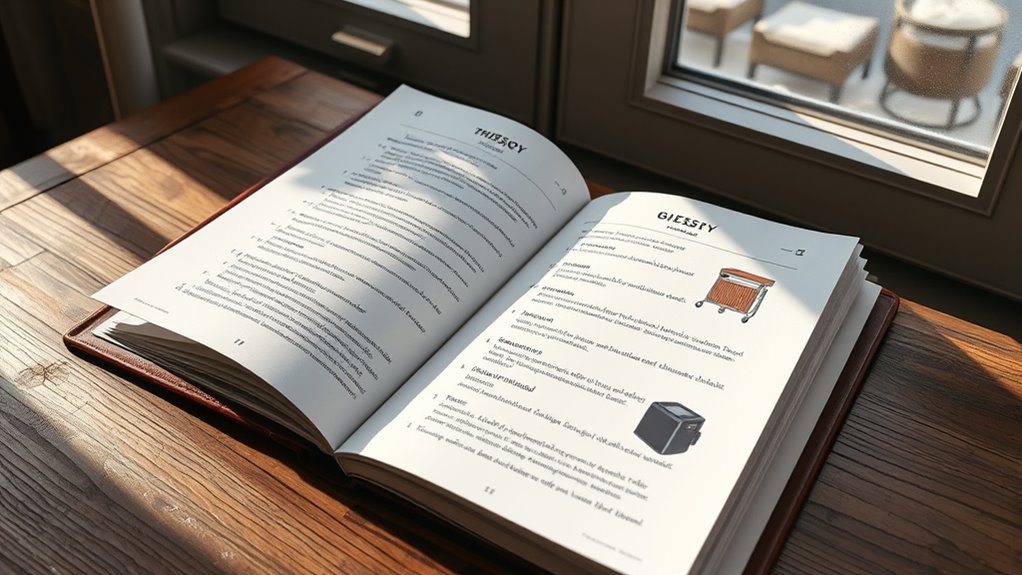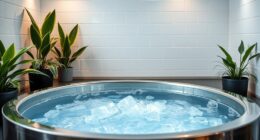A no-nonsense guide to post-plunge warming strategies helps you understand key terms like passive techniques, such as using insulating clothing and environmental adjustments, while active methods include applying heat packs or warm water. Shift tactics focus on gradual rewarming to prevent shock, and proper layering ensures safety and comfort. Monitoring your body’s responses is crucial to avoid overexposure. If you continue exploring, you’ll find practical insights to safely recover and maintain core warmth after cold immersion.
Key Takeaways
- Definitions of passive and active warming techniques used after cold exposure.
- Explanation of gradual rewarming methods to prevent shock and overexposure.
- Monitoring signs of hypothermia and cold shock for safe rewarming.
- Breathing and relaxation exercises to aid recovery and stabilize body functions.
- Environmental and safety precautions during post-plunge warming to avoid injury.
Passive Warming Techniques

Passive warming techniques rely on natural insulation and environmental adjustments to maintain body heat without active energy input. You can enhance passive heat retention by choosing clothing made from thermal insulation materials that trap warm air close to your skin. Layering is key; wearing multiple layers creates air pockets that act as insulation barriers. Using dry, windproof, and waterproof outerwear helps prevent heat loss caused by wind and moisture. Additionally, sheltering yourself from drafts and cold surfaces minimizes heat transfer away from your body. Properly insulating your head and extremities also boosts passive heat retention, since these areas lose heat quickly. By focusing on environmental adjustments and clothing choices, passive warming helps sustain your core temperature efficiently after a plunge.
Active Warming Methods
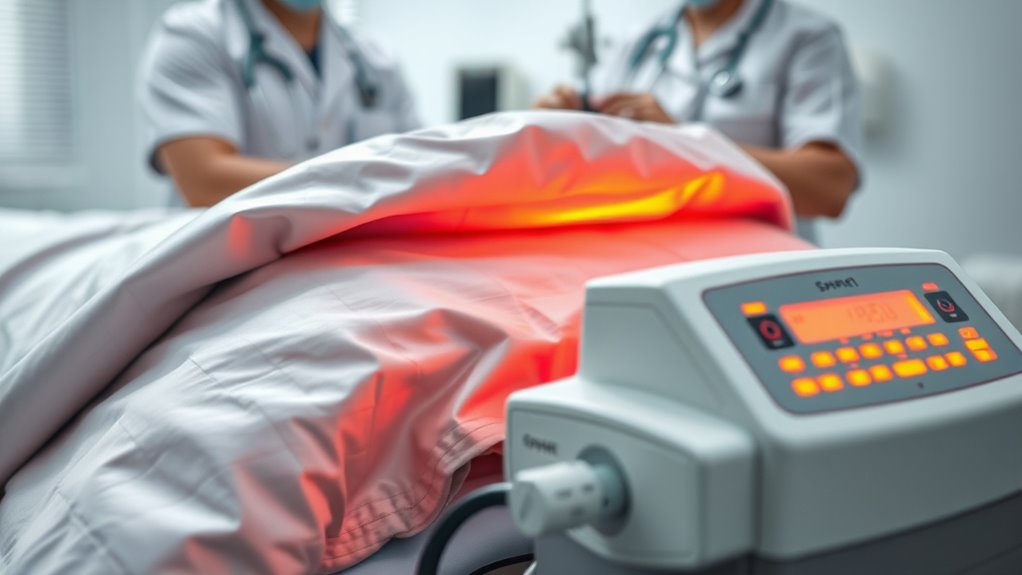
Active warming methods involve applying external heat sources to quickly elevate your body temperature after exposure to cold. When you’ve experienced cold exposure, your body heat drops rapidly, so active warming helps restore warmth faster than passive methods alone. Use blankets, heating pads, or hot packs directly on your skin to generate heat quickly. Warm, dry clothing can also insulate and trap your body heat. Immersing yourself in warm water or using forced-air warming devices are effective options for accelerating rewarming. The key is to deliver heat directly to your core and extremities, preventing hypothermia and promoting faster recovery. Remember, active warming methods are essential when you need rapid temperature restoration, especially in situations where cold exposure has been prolonged or severe. Effective heat transfer techniques can also enhance the efficiency of your warming efforts and ensure even heat distribution across your body.
Transition Period Strategies

During the changeover period, you should focus on gradually reintroducing warmth to prevent shock. Keep a close eye on your body’s responses to avoid overdoing it. This careful approach helps guarantee a safe and effective recovery process. Monitoring temperature regulation is essential to ensure a smooth transition.
Gradual Temperature Reintroduction
As you begin reintroducing warmer temperatures after a plunge, it’s essential to do so gradually to prevent shock and guarantee safety. This slow approach allows your body to adapt smoothly to changing conditions, reducing stress on your systems. To facilitate a safe shift, consider these strategies:
- Incrementally increase water or ambient temperature over several sessions
- Avoid sudden jumps in temperature to prevent cold exposure shock
- Pay attention to your body’s signals for signs of overstress
- Use gentle movement to help your body adapt gradually
- Incorporating gradual temperature reintroduction strategies can also help minimize potential health risks associated with rapid changes.
Monitoring Body Responses
Monitoring your body’s responses is essential when shifting back to warmer temperatures, as it helps you identify signs of stress or discomfort early on. Watch for cold shock symptoms like rapid breathing or dizziness, which can indicate your body is struggling. Be alert for hypothermia signs such as shivering, confusion, or numbness. Keeping track of these responses allows you to adjust your warming efforts promptly and safely. Use the following table to recognize potential issues:
| Response | Warning Signs | Action |
|---|---|---|
| Cold Shock | Rapid breathing, dizziness | Slow down, breathe deeply, seek warmth |
| Mild Discomfort | Shivering, cold extremities | Continue warming gradually |
| Hypothermia Signs | Confusion, numbness, weakness | Increase heat, seek shelter, medical help |
| Body Temperature Drop | Feeling cold, pale skin | Use blankets, warm fluids |
| Heart Rate Changes | Irregular heartbeat | Seek medical attention immediately |
Additionally, be aware that the body’s response to temperature changes can vary based on individual health factors, so monitoring closely is vital. Stay vigilant to guarantee safe transition and avoid complications.
Clothing and Layering Tips
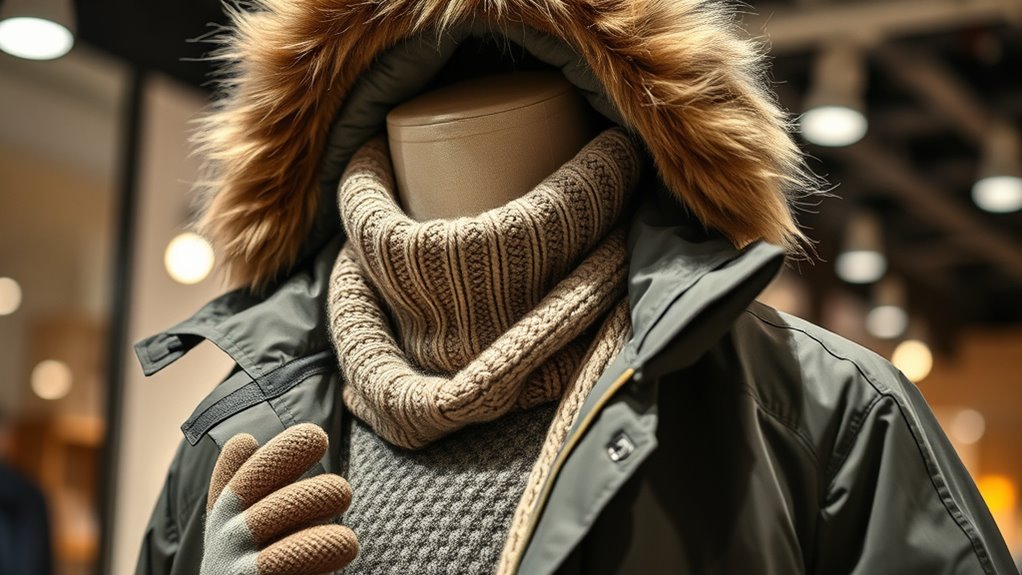
Choosing the right clothing and layering effectively are essential for staying warm after a plunge. Your goal is to maximize thermal insulation while managing moisture to prevent heat loss. Start with a moisture-wicking base layer to keep sweat away from your skin. Add insulating layers like fleece or wool to trap heat. Finish with a waterproof, windproof outer layer to shield against the elements. Proper layering ensures your body retains heat and stays dry, making your post-plunge recovery safer and more comfortable. Be aware that pinball machine weight can vary significantly, so handling and transportation should be planned carefully to avoid injury.
Warm Drinks and Nutrition

After confirming you’re dressed appropriately with layers that keep heat in and moisture out, focusing on what you consume can substantially boost your recovery. Warm drinks like herbal infusions provide soothing comfort and gentle warmth without caffeine, aiding relaxation. Prioritize nutrient timing; eating small, balanced meals with easily digestible carbs and proteins helps replenish energy and repair tissues. Incorporate nutrient-rich foods such as soups or broths to supply essential minerals and electrolytes. Avoid heavy, greasy foods immediately after the plunge, as they can hinder recovery. Instead, opt for warm beverages and nutritious snacks to support core temperature restoration and replenish depleted nutrients. Staying mindful of what you consume ensures your body recovers efficiently, reducing cold effects and promoting overall warmth and well-being. Utilizing water park amenities like heated pools and splash zones can further enhance your post-plunge comfort and relaxation.
Hydration and Electrolyte Replenishment

Have you considered how essential proper hydration is after a cold plunge? Replenishing fluid intake helps restore your body’s electrolyte balance and supports recovery. Cold exposure can cause fluid loss through increased urination or sweating, making hydration critical. To optimize your recovery, focus on:
- Drinking electrolyte-rich fluids like sports drinks or coconut water
- Incorporating mineral salts into your hydration routine
- Monitoring urine color for hydration status
- Consuming hydrating foods such as fruits and vegetables
- Recognizing the importance of sustainable hydration practices to minimize environmental impact and promote eco-friendly choices
Ensuring you maintain electrolyte balance prevents cramps and fatigue, while adequate fluid intake helps your body warm up efficiently. Staying proactive with hydration after a plunge supports quicker recovery, enhances circulation, and prepares your body for subsequent activities. Proper hydration isn’t just about quenching thirst; it’s key to your post-plunge well-being.
Breathing and Relaxation Exercises

You can help your body recover faster by practicing controlled breathing techniques, which calm your nervous system and reduce stress. Progressive relaxation methods target tense muscles, easing discomfort after a plunge. Incorporating these exercises into your routine makes warming up more effective and restores your sense of calm. Additionally, practicing mindfulness techniques such as deep breathing exercises can enhance your focus and promote relaxation during recovery.
Controlled Breathing Techniques
How can controlled breathing techniques help you recover after a plunge? They assist in restoring your body’s balance by regulating breathing patterns, reducing stress, and promoting relaxation. When you focus on controlled breaths, you activate your parasympathetic nervous system, helping you cool down and stabilize your heart rate. These relaxation techniques can alleviate tension and prevent panic or hyperventilation. To practice, try:
- Slow, deep inhalations through the nose
- Extended exhalations to release tension
- Pausing briefly between breaths
- Maintaining steady, consistent breathing patterns
Incorporating mindfulness can also enhance the effectiveness of these techniques by fostering present-moment awareness. These techniques help you stay calm and centered, making your post-plunge recovery more efficient. Incorporating controlled breathing into your routine ensures you remain relaxed and better prepared for the next phase of warming.
Progressive Relaxation Methods
Progressive relaxation methods combine controlled breathing with targeted muscle tension and release to help your body unwind after a plunge. Start by focusing on your breath, inhaling deeply, then exhaling slowly to calm your mind. As you breathe, tense specific muscle groups, like your shoulders or legs, for a few seconds before relaxing them completely. Incorporate muscle stretching to enhance relaxation and reduce stiffness. Using mental imagery, visualize warmth spreading through your muscles as they relax. This technique not only eases physical tension but also calms your mind, making it easier to recover from cold exposure. Emotional and psychological growth are supported through these relaxation exercises, aiding overall recovery. With consistent practice, these exercises become a powerful tool to promote relaxation, improve circulation, and support your post-plunge warming efforts.
Safe Rewarming Practices
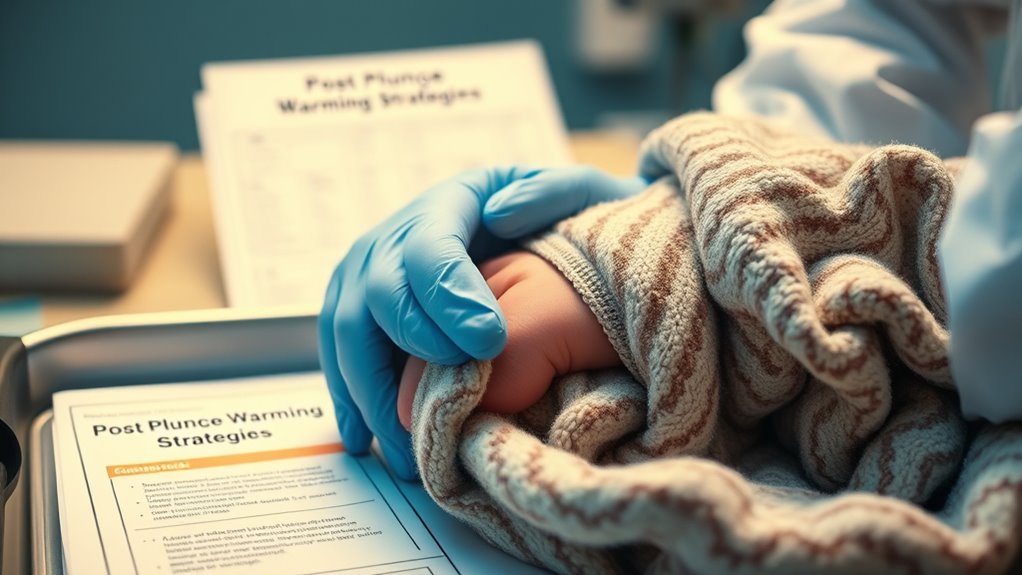
When rewarming someone after a plunge, following safe practices is essential to prevent further injury or complications. Proper rewarming promotes hypothermia prevention and reduces risks associated with cold exposure awareness. Keep the person in a warm, sheltered environment, avoiding sudden temperature changes. Use gentle methods like insulating blankets or heat packs applied to the core, not extremities. Avoid hot water baths or direct heat sources, which can cause shock. Monitor their breathing and consciousness closely. Remember, gradual rewarming is key to avoiding rewarming shock.
Rewarm gradually in a warm, sheltered environment with insulating blankets, avoiding sudden changes or direct heat sources.
- Keep the individual wrapped in dry, insulating layers
- Focus on core areas like the chest and groin
- Ensure a warm, sheltered environment
- Avoid rapid temperature changes or direct heat
Monitoring Your Body’s Response

Ever wonder why closely monitoring your body’s responses is vital during rewarming? When you’re exposed to cold, your body works hard to maintain thermal regulation. Tracking signs like shivering, skin color, and heart rate helps you gauge progress and prevent over- or under-warming. Recognizing these cues guarantees safe rewarming, especially after cold exposure. Here’s a quick picture:
| Symptom | Indicator | Action |
|---|---|---|
| Shivering | Body trying to generate heat | Continue gentle warming |
| Pale or bluish skin | Reduced blood flow | Increase warmth gradually |
| Rapid heartbeat | Stress response | Slow down rewarming |
| Numbness | Cold extremities | Focus on core warming |
| Fatigue | Exhaustion from thermal regulation | Rest and reassess |
Monitoring these responses keeps you in control, optimizing safe, effective rewarming.
Frequently Asked Questions
How Do I Recognize Early Signs of Hypothermia During Rewarming?
To recognize early signs of hypothermia during rewarming, pay attention to shivering cues, which may become uncontrollable or stop suddenly. Look for skin color changes, such as pallor or a bluish tint, especially on extremities. You might also notice confusion, sluggishness, or clumsiness. These cues indicate your body is struggling to maintain heat, so act quickly to prevent worsening symptoms and seek medical help if needed.
Can Certain Medications Interfere With Post-Plunge Warming Efforts?
Think of your body as a delicate garden, and medications as the weather. Certain medications, through medication interactions and drug effects, can hinder your body’s warming process, like a sudden frost damaging your plants. Some drugs may slow circulation or interfere with blood flow, making rewarming less effective. Always consult your healthcare provider before post-plunge warming, so they can adjust medications if needed, ensuring your body’s recovery isn’t thwarted by unseen drug effects.
What Are Common Mistakes to Avoid During Active Rewarming?
You should avoid rushing procedures and improper insulation during active rewarming. Rushing can cause rapid temperature shifts, increasing the risk of complications. Improper insulation leaves the body vulnerable to heat loss, delaying recovery. Focus on gradual warming, guaranteeing proper insulation around the patient’s core and extremities. Never skip monitoring vital signs closely, and don’t neglect to keep the patient dry and shielded from environmental elements. This careful approach ensures safer, more effective rewarming efforts.
Is There a Recommended Timeline for Safe Rewarming Completion?
You should aim to complete rewarming within specific timing guidelines to guarantee safety. Generally, rewarming deadlines depend on the severity of hypothermia but aim for gradual warming over several hours. Keep monitoring the patient’s condition closely and avoid rushing the process. Prioritize steady, controlled rewarming to prevent complications, and consult medical professionals if uncertain about timing or progress. Proper adherence to these guidelines helps prevent further risks.
How Do Psychological Factors Affect Recovery After Cold Exposure?
You might think psychological factors don’t matter much, but mental resilience plays a pivotal role in recovery after cold exposure. Your emotional response can either hinder or help your body’s healing process. Staying calm and positive boosts circulation and speeds warming, while panic or fear can worsen symptoms. Focus on deep breathing and visualization to maintain control, making your mental state an active part of your physical recovery.
Conclusion
Staying warm after a plunge is essential for your safety and comfort. Did you know that hypothermia risk increases by 30% if you don’t rewarm properly? By applying the right techniques—like layered clothing, warm drinks, and gentle movements—you can considerably lower that risk. Remember, listening to your body’s signals and rewarming gradually helps prevent complications. Keep these strategies in mind, and you’ll enjoy your cold water adventures safely and confidently.
